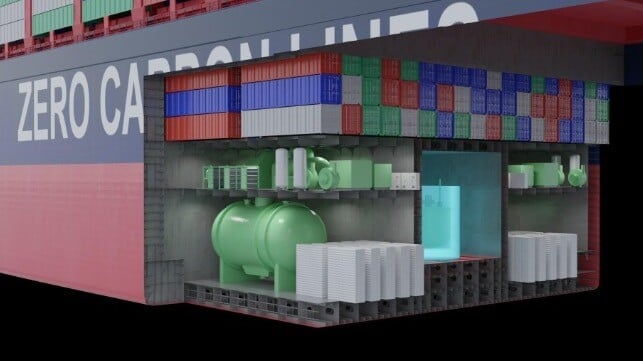ABS Completes Groundbreaking Study on Nuclear-Powered Merchant Ships

The American Bureau of Shipping has completed a landmark study on the use of nuclear propulsion aboard large ships, a proven concept which has received new attention for civilian applications because of its carbon-free profile.
Under a contract from the U.S. Department of Energy, ABS worked with Hebert Engineering Corp. to model the application of nuclear propulsion for two common vessel classes: a 14,000 TEU Post-panamax boxship and a 157,000 dwt Suezmax tanker. With input from leading nuclear reactor developers, the ABS-HEC team modeled the installation of two different powerplants aboard these two hull types.
For the boxship, the team selected a twin-reactor, lead-cooled, 30MW fast reactor design with total installed power of 60MW (80,000 horsepower). They determined that this arrangement would increase cargo capacity and operating speed for the ship.
The lead-cooled fast reactor is not found in commercial settings, but it has been used in a maritime application before. The Soviet Navy employed a lead-bismuth cooled fast reactor aboard its ultra-fast Alfa-class attack subs, which were capable of more than 40 knots underwater. The advantages of this low-pressure, high-temperature reactor design include compactness and inherent safety: there is no need for a pressure vessel, and the coolant solidifies in the event of a leak or shutdown.
On the Suezmax tanker, the team studied the possibility of installing a different power configuration - a set of four 5MW heat-pipe microreactors, with total installed power of 20MW (27,000 horsepower). The study found that this would increase the tanker's speed, but would reduce its cargo capacity.
A heat-pipe microreactor uses a passive cooling system incorporating long, hollow pipes filled with a self-circulating heat transfer fluid. The technology dates back to Cold War-era research on nuclear reactors for space applications, and it is still experimental. Technical advantages include small reactor size and fewer moving parts.
For both reactor technologies and vessel design cases, the fuel core would last 25 years - the typical operational life of a merchant ship - and the vessel would have zero CO2 emissions.
“A net-zero world is more easily realized through nuclear propulsion, and we are putting in place the foundations for that future today,” said Christopher J. Wiernicki, ABS Chairman and CEO. “Advanced or small modular reactors address many of the issues traditionally associated with nuclear for commercial maritime use, with enhanced safety and efficiency, reduced cost and waste and proliferation prevention. Nevertheless, many questions need to be answered and it is critical that industry evaluate these technologies with a laser focus on safety.”

that matters most
Get the latest maritime news delivered to your inbox daily.
The Department of Energy has also contracted ABS to support research into thermal-electric integration of a nuclear propulsion system on a commercial vessel, which is being carried out by the University of Texas.
Nuclear power has a long history in naval applications, and while it was viewed to have great potential for the maritime industry in the 1950s, it failed to develop due to safety concerns and the challenges of operating the systems aboard ships. The U.S. ultimately built one demonstration commercial ship, the NS Savannah. Russia is the only country that continues to operate a nuclear-powered cargo ship today.
